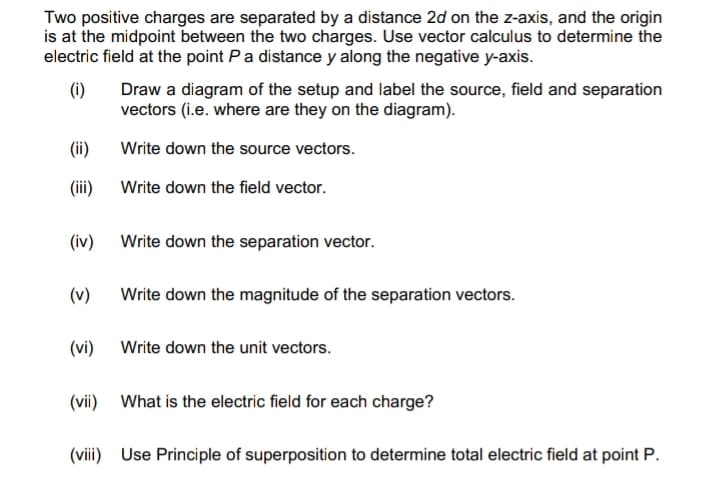Two positive charges are separated by a distance 2d on the z-axis, and the origin is at the midpoint between the two charges. Use vector calculus to determine the electric field at the point P a distance y along the negative y-axis. (i) (ii) (iii) (iv) (v) (vi) Draw a diagram of the setup and label the source, field and separation vectors (i.e. where are they on the diagram). Write down the source vectors. Write down the field vector. Write down the separation vector. Write down the magnitude of the separation vectors. Write down the unit vectors. (vii) What is the electric field for each charge? (viii) Use Principle of superposition to determine total electric field at point P.
Two positive charges are separated by a distance 2d on the z-axis, and the origin is at the midpoint between the two charges. Use vector calculus to determine the electric field at the point P a distance y along the negative y-axis. (i) (ii) (iii) (iv) (v) (vi) Draw a diagram of the setup and label the source, field and separation vectors (i.e. where are they on the diagram). Write down the source vectors. Write down the field vector. Write down the separation vector. Write down the magnitude of the separation vectors. Write down the unit vectors. (vii) What is the electric field for each charge? (viii) Use Principle of superposition to determine total electric field at point P.
Principles of Physics: A Calculus-Based Text
5th Edition
ISBN:9781133104261
Author:Raymond A. Serway, John W. Jewett
Publisher:Raymond A. Serway, John W. Jewett
Chapter19: Electric Forces And Electric Fields
Section: Chapter Questions
Problem 32P
Related questions
Concept explainers
Dielectric Constant Of Water
Water constitutes about 70% of earth. Some important distinguishing properties of water are high molar concentration, small dissociation constant and high dielectric constant.
Electrostatic Potential and Capacitance
An electrostatic force is a force caused by stationary electric charges /fields. The electrostatic force is caused by the transfer of electrons in conducting materials. Coulomb’s law determines the amount of force between two stationary, charged particles. The electric force is the force which acts between two stationary charges. It is also called Coulomb force.
Question
Do all

Transcribed Image Text:Two positive charges are separated by a distance 2d on the z-axis, and the origin
is at the midpoint between the two charges. Use vector calculus to determine the
electric field at the point P a distance y along the negative y-axis.
(i)
(ii)
(iii)
(iv)
(v)
(vi)
Draw a diagram of the setup and label the source, field and separation
vectors (i.e. where are they on the diagram).
Write down the source vectors.
Write down the field vector.
Write down the separation vector.
Write down the magnitude of the separation vectors.
Write down the unit vectors.
(vii) What is the electric field for each charge?
(viii) Use Principle of superposition to determine total electric field at point P.
Expert Solution
This question has been solved!
Explore an expertly crafted, step-by-step solution for a thorough understanding of key concepts.
Step by step
Solved in 3 steps with 3 images

Knowledge Booster
Learn more about
Need a deep-dive on the concept behind this application? Look no further. Learn more about this topic, physics and related others by exploring similar questions and additional content below.Recommended textbooks for you

Principles of Physics: A Calculus-Based Text
Physics
ISBN:
9781133104261
Author:
Raymond A. Serway, John W. Jewett
Publisher:
Cengage Learning

College Physics
Physics
ISBN:
9781285737027
Author:
Raymond A. Serway, Chris Vuille
Publisher:
Cengage Learning


Principles of Physics: A Calculus-Based Text
Physics
ISBN:
9781133104261
Author:
Raymond A. Serway, John W. Jewett
Publisher:
Cengage Learning

College Physics
Physics
ISBN:
9781285737027
Author:
Raymond A. Serway, Chris Vuille
Publisher:
Cengage Learning


Physics for Scientists and Engineers: Foundations…
Physics
ISBN:
9781133939146
Author:
Katz, Debora M.
Publisher:
Cengage Learning

Physics for Scientists and Engineers
Physics
ISBN:
9781337553278
Author:
Raymond A. Serway, John W. Jewett
Publisher:
Cengage Learning

Physics for Scientists and Engineers with Modern …
Physics
ISBN:
9781337553292
Author:
Raymond A. Serway, John W. Jewett
Publisher:
Cengage Learning